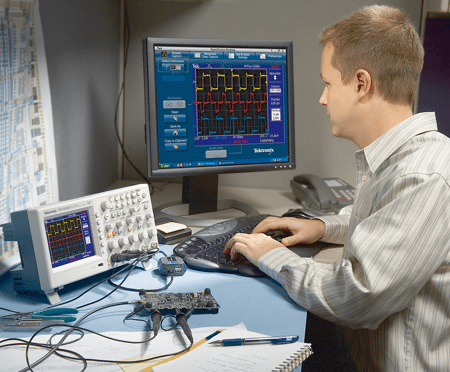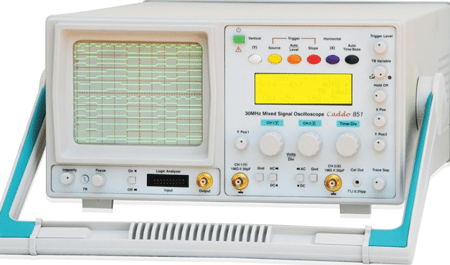Higher analogue bandwidth, higher sampling rate, higher memory points and faster response are the biggest trends seen in oscilloscopes. But inbuilt support for connectivity to a computer or the network is the key specification that will drive the next-generation scopes
SHWETA DHADIWAL BAID

Equipment vendors had foreseen that test and debug engineers would need to connect their equipment to the computer. Connectivity through various standards and modes has thus become the biggest trend in oscilloscopes today. As the computers continue to deliver higher performance and speed, they have become an attractive option for higher deliverables in test and measurement.
According to a Frost & Sullivan report, the oscilloscope market is primarily driven by constant technology innovations in the communication and computer industry. In 2009, the world oscilloscope market generated revenues of $987.7 million, which is expected to reach $1513.4 million by 2014 as the demand for new products with enhanced features like PC connectivity along with Internet support increases.
The transition from analogue to digital in the communication and computer industry has given rise to the need for high-performance RF test tools, which has accelerated the demand for digital as well as PC-based oscilloscopes or digitisers. Users demand connectivity not only for waveform data transfer but also for control and remote access of the equipment. Thus Ethernet, universal serial bus (USB) and general-purpose interface bus (GPIB) have become key specifications in next-generation oscilloscopes.
Modularity and virtual instrumentation is another technology trend seen in oscilloscopes, where the computer becomes the front-end screen while PXI or LXI ports enable the connectivity of oscilloscope hardware.
The phase of change
Oscilloscopes are the basic test and debug equipment found in every phase of electrical or electronic development. As consumer and industrial products become more intelligent with advanced embedded electronics, vendors aim at providing more and more features that are vital to supply products which are based on the new standards.
“Oscilloscopes have evolved from the traditional analogue scopes to high-performance digital oscilloscopes. Today, oscilloscopes have extremely high-speed analogue-to-digital converters (ADCs) and a huge memory of nearly 2 giga-points,” informs Sanchit Bhatia, digital applications’ consultant, Agilent Technologies. They have unprecedented analysis capabilities and more and more automated compliance software.
“Deeper memories, higher sampling rates, colour TFT and LCD wide-screen displays, and built-in options like function generator, DSO demonstrator and multichannel logic analyser are the major technological developments seen in oscilloscopes,” shares Chandeep Singh, CEO, Silicom Electronics.
In addition to the internal technology of the device, the development and enhancement of the probes play a very important role. Naresh Narasimhan, pacific technical marketing manager, Tektronix, says, “The highest-bandwidth oscilloscope is of little use to the user if the signal cannot be tapped and directed to the device.”
Connectivity to PC
Computer has become an inseparable part of test and measurement instrumentation. Digitisation has made it easier to take the oscilloscope signal on a PC. Bruce Tulloch, director-software development, BitScope, believes, “Products that leverage power of personal computers, netbooks and tablets are expected to become even more common. These are generally more useful than traditional standalone oscilloscopes because they can be produced at lower cost, are more flexible in use, and can meet or exceed the specifications of many standalone solutions.”
“In earlier days, analogue oscilloscope required single-shot external signal out and a special camera was required to capture the image. With the advent of digitisation, the same signal is captured in the memory and can be seen on the digital storage oscilloscope (DSO) screen or taken to a PC via USB, RS-232, GPIB, LAN, etc,” shares Neelam Kumar, executive director, Aplab.
“The scopes come with USB host feature, so the waveform image can be captured directly onto a USB flash drive without the need of PC,” adds Kumar.
“Analogue scopes have also entered the area of Ethernet connectivity and multi-location applications,” informs J.K. Baldua, director-technical, Scientech Technologies.
High-speed interface for data transfer
Oscilloscopes help capture signal waveforms and analyse them for performance. The increasing complexity of the signals and the challenges associated with signal integrity and high-speed data acquisition have stirred up the performance requirements of digital scopes.

Bhatia shares, “The oscilloscope market is now witnessing increasing adoption of high-speed serial data bus technologies like PCI Express, serial advanced technology attachment (SATA) and HDMI. As the memory depth of digital storage oscilloscope has increased to 2 giga-points, these interfaces facilitate faster data transfers.”
GPIB phases out, USB takes in
USB has almost replaced GPIB in instrumentation control. The plug-and-play capability of USB is widely used in many form factors in oscilloscopes. Today, users demand performance along with ease of operation. As USB is the most commonly adopted standard in the PC world, you do not have to write the code or install drivers separately while connecting a hardware using USB port to your computer.
USB PC-based oscilloscopes eliminate the need for an external power supply and can be conveniently used with a laptop or notebook computer. Standalone box oscilloscopes offer more than one USB port for connectivity to other equipment as well as computer.
Bhatia shares, “In some of the older aerospace and defence applications, when the automated test algorithms for controlling the overall system use GPIB for control, you may require a USB-to-GPIB converter if you use a latest oscilloscope with USB port.” Many companies including Agilent and National Instruments provide USB-to-GPIB and GPIB-to-high-speed-USB connectors.
Although USB offers all the flexibility and ease of operation, there are some issues around it. Nandini Subramanya, marketing communications manager, National Instruments, informs, “USB 2.0 does not necessarily mean high speed as USB standards provide different data rates. When a device is called USB 2.0-compatible, it supports the low- (1.5Mbps) and full-speed (12Mbps) transfer rates. To ensure greater transfer rates, you should purchase an instrument with high-speed USB (480Mbps).
“There are two types of USB ports. Type A ports are flat and elongated. Normally found on computers, these are typically used to save data to USB memory sticks and not for instrument control. For controlling your instrument through a PC, you need Type B device port, which is more like a square shape.”







